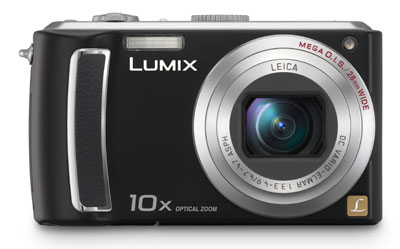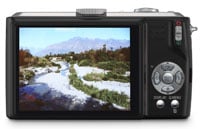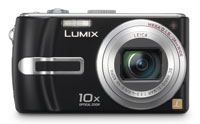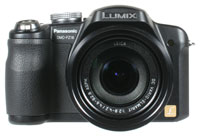Panasonic Lumix DMC-TZ5
-
-
Written by Gordon Laing
Panasonic Lumix DMC-TZ5 verdict
The Panasonic Lumix DMC-TZ5 remains one of the most flexible compact cameras on the market – and one which has few if any rivals. Like its predecessor, it may not be the slimmest compact on the market, but uniquely packs in a 10x optical zoom lens complete with image stabilisation and a 28mm equivalent wide angle.
The flexibility and convenience of having such a long reach in a relatively pocketable body cannot be underestimated. You’ll enjoy the kind of opportunist shots which only a long zoom can deliver, but at times when you’re unlikely or unwilling to carry a larger camera.
By sharing the same lens as its predecessor, the Lumix TZ5 also inherits its optical quality which considering the physical constraints, is remarkably good. Geometric distortion and light fall-off are kept to a respectable minimum, while coloured fringing is virtually non-existent across the entire focal range. The overall contrast may fall-off as you zoom-in, but this is par for the course with many super-zooms and easily corrected in software afterwards.
 |
Of course all of this was possible with the earlier Lumix TZ3, so what about the new features? Starting with the HD video recording facility, it certainly produces footage with greater detail than the standard definition modes and it’s nice to have an optional Component video cable to view them (and slideshows) on an HDTV.
But like all video modes on still cameras, don’t expect miracles. The TZ5’s HD recording may look better than its own SD modes, but it’s not a patch on a dedicated HD camcorder or even a higher-end SD model – and like most compacts, the audio is still pretty ropey. So it’s a nice feature to have, but still no replacement for a proper camcorder. See our Features page for more details on this and the ability to optically zoom while filming.
 |
Next up is the higher resolution 3in screen which sits directly in-between common 230k and high-end 920k monitors in terms of detail. In use the TZ5 only appears to exploit this higher resolution during playback; indeed when composing shots in record mode or navigating menus, you seem to be viewing a scaled 230k image. But switch the camera to playback and the extra detail becomes immediately apparent. It’s not as significant as the jump to 920k VGA monitors, but is still a noticeable and welcome improvement.
Now onto Intelligent Auto, which is the latest evolution in Panasonic’s automatic modes. This takes the Intelligent ISO of the TZ3, adds Face and Scene detection (from the late 2007 models), and tops it off with the brand new Intelligent Exposure facility. The latter is Panasonic’s take on the dynamic range optimisation modes which frequent today’s cameras and attempt to preserve detail in both highlights and shadows. Panasonic does it by exposing for the highlights then boosting the sensitivity in selected areas of the sensor to brighten shadow areas.
In use we didn’t see much benefit of this Intelligent Exposure in our own test shots, but the addition of Face and Scene detection is a valuable enhancement for the TZ5 over its predecessor. Scene detection in particular does an uncannily good job of identifying the kind of shot you’re trying to take and selecting the most appropriate preset – it’s one of the best auto modes we’ve tested.
And finally to the increase in sensor resolution. In studio tests, the TZ5’s additional two Megapixels record measurably greater detail, and thankfully the noise levels don’t appear worse than the TZ3. But in terms of real-life detail, there’s little difference, so don’t buy the TZ5 just for its higher resolution.
It should also be noted the TZ5, like all compacts these days, greatly suffers at higher sensitivities. Keep it at 100 ISO and you’ll be happy, but anything higher, especially beyond 200 ISO, and the results rapidly deteriorate. And like its predecessor, the TZ5 remains pretty much an automatic camera only, so if you want manual control over exposure or focus, look elsewhere.
So before wrapping-up how does it compare to rival models?
Compared to Panasonic Lumix DMC-TZ3
Since the new TZ5 is such a unique compact, the most appropriate comparison is against its predecessor. The earlier TZ3 shares the same 10x optical zoom lens with 28-280mm equivalent coverage and stabilisation. It also has essentially the same body and design, although some controls have been moved around. In the new TZ5’s favour are a more detailed screen in playback (although it’s the same 3in size), the ability to record HD movies (although the TZ3 still has a decent 848×480 mode), face and scene detection as part of a more cunning auto mode, and two extra Megapixels. While we’d say the new features of the TZ5 are worth having for its asking price, it’s important to note the TZ3 has the same lens in the same body for as much as 30% less. So if you can live without the TZ5’s new frills, the TZ3 simply represents fantastic value while stocks last. See our Panasonic Lumix DMC-TZ3 review for more details. |
Compared to Panasonic Lumix DMC-FZ18
The FZ18 is arguably the next model up from the TZ5, in terms of optical range anyway. It’s a much more serious looking camera, styled like a DSLR, although it actually feels less substantial than the TZ5. The key differences in the FZ18’s favour are a longer 18x optical zoom range and full manual control, including the ability to record RAW files. As a newer camera though, the TZ5 has a bigger and more detailed screen, HD video recording, a more sophisticated auto mode, along with an extra Megapixel. If you can live in automatic with a 10x zoom, then the TZ5 is probably a better bet, but for those who demand manual control, a longer zoom range and prefer the SLR grip and styling, then the FZ18 is a superb choice. It remains our favourite Super-zoom camera. See our Panasonic Lumix DMC-FZ18 review for more details. |
Panasonic Lumix DMC-TZ5
Final verdict
As we commented of its predecessor, it’s hard to find cameras to rival the Lumix TZ5 because it simply represents a unique proposition on the market. After all, while there’s plenty of super-zoom cameras with stabilisation, none can squeeze into a trouser or coat pocket like the TZ5.
The lack of manual control can be annoying for enthusiasts, and the performance at higher sensitivities is, like most compacts, nothing to be proud of. But these are about the only real downsides to the TZ5. So if you’re happy to leave your creativity to various scene presets and limit the sensitivity to 100 or 200 ISO then you’ll enjoy some great-looking photos.
The only fly in the ointment is the earlier TZ3 which may not sport the TZ5’s latest gadgetry, but still shares the same lens and form factor. So if you can live without the new features, it represents superb value while stocks last.
That said, the asking price of the new TZ5 remains very reasonable and by adding several neat new features, Panasonic has improved on what was already a winning model. The HD movies may be no replacement for a proper camcorder, but they’re still impressive, as are the more detailed screen in playback and the improved automatic facilities.
But it’s the core feature which still impresses. As we said of its predecessor, the TZ5 is a highly compelling proposition for anyone who wants the flexibility and power of a long zoom with the carry-everywhere convenience of a compact. Once again Panasonic has a camera that easily deserves our Highly Recommended rating.
|
Bad points | Scores (relative to 2008 compacts) |
 | ||
Build quality: Image quality: Handling: Specification: Value:
Overall: | 18 / 20 16 / 20 16 / 20 19 / 20 18 / 20
87% | |||
| ||||






